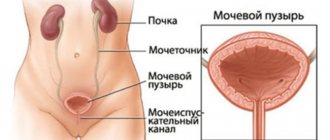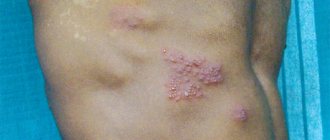- Routes of transmission of the virus
- Diseases caused by herpesvirus
- Characteristic signs of the disease
- Stages of genital herpes
- Types of herpes virus infection
- Genital herpes in pregnant women
- Genital herpes in newborns
- Diagnosis of genital herpes
- Treatment of genital herpes
- Prevention of genital herpes
This is one of the most common sexually transmitted viral diseases and represents a fairly important medical and social problem. It differs from other herpesvirus infections by lifelong carriage and is characterized by frequent relapses. Due to the fact that undiagnosed and asymptomatic forms of pathology have recently become very common, the incidence of genital herpes is constantly growing. According to statistics, the virus affects almost 90% of the world's population.
The causative agent of the disease is type I and II filterable herpes simplex virus (HSV-1 and HSV-2). This is a large, enveloped virion from the genus Herpesvirus, family Herpetoviridae, containing double-stranded DNA and reaching 180 nm. A virion (a complete viral particle) consists of a nucleocapsid (DNA core), which allows it to integrate and cause malignant transformation of the host’s genetic apparatus, and a protein capsid (viral shell). The virion capsid includes 162 capsomeres, an outer membrane and an inner envelope. It also contains lipids, glyco- and lipoproteins, spermidine and spermine necessary for life.
The herpes virus is inactivated in 30 minutes at a temperature of +50-52 degrees, and in 10 hours at a temperature of +37 degrees Celsius. The pathogen can maintain its pathogenicity at low temperatures (down to -70 degrees) and is very resistant to ultrasound. It dies under the influence of ultraviolet and x-rays, alcohol, organic solvents and proteolytic enzymes. Also, the genital herpes virus is sensitive to formalin, phenol and potassium permanganate. HSV types I and II belong to the subfamily of alphaherpeviruses, which have a pronounced cytotoxic effect and persist in humans throughout their lives in various parts of the nervous system. The pathogen requires a very short period of time for full development, and it is also capable of spreading quite quickly throughout the cells of its host.
Note: The herpevirus type HSV-1 causes relapses of the disease much less frequently than HSV-2.
Routes of transmission of the virus
The source of herpes virus infection is a sick person or a virus carrier. The main routes of transmission include:
- Airborne;
- Transfusion (through blood or its components);
- For tissue and organ transplantation;
- Contact;
- Transplacental (through the placenta from mother to fetus);
- Intrapartum (during childbirth).
According to experts, primary infection with the genital herpes virus occurs in early childhood through airborne droplets from adult family members with pronounced signs of herpes virus infection.
The main links of pathogenesis:
- The ability of the genital herpes virus to infect epithelial and nerve cells, which determines the diversity of clinical manifestations of herpes virus infection.
- Damage to immunocompetent cells by the pathogen (this leads to secondary immunodeficiency).
- Infection of the sensory nerve ganglia of the autonomic nervous system and the ability of the virus to remain there for life.
The entry points for infection in genital herpes are the mucous membranes of the genitals and oral cavity, conjunctiva, red border of the lips and skin. After the introduction of the pathogen, typical rashes in the form of watery blisters appear on the affected areas. Next, the infectious agent penetrates the bloodstream and vessels of the lymphatic system. At the earliest stages of the pathological process, virions are able to penetrate the nerve endings of the skin and mucous membranes. Then they move centripetally along the axoplasm to the peripheral and segmental regional sensory ganglia of the central nervous system.
Causes and routes of infection
photo genital herpes in women
Genital herpes in women in gynecology occupies a leading position among infectious and inflammatory diseases of the reproductive tract and is the cause of chronicity of various infections, as well as infertility and pathology of the epithelium of the cervical uterus. The cause of the genital form is herpes simplex virus type 2, but type 1 virus (HSV2 and HSV1) is also often diagnosed.
Genital herpes in women often remains unrecognized due to insufficient diagnosis of infectious diseases, as it occurs subclinically.
Asymptomatic virus carriage accounts for up to 70% of cases of transmission of genital herpes, since the absence of significant symptoms does not create restrictions on sexual intercourse.
The virus is transmitted:
- Sexually. Infection occurs during any type of sexual contact with both a patient with genital herpes and a carrier.
- Through autoinoculation. If there are viral blisters on the face, the pathogen can be carried by hands to the genitals.
- Through household contact in the presence of virions on common hygiene items (usually occurring in children).
To introduce a pathogen into the skin, damage is necessary: small cracks, abrasions, and abrasions are enough to become infected.
The pathogen penetrates the mucous membranes freely, which is why women become infected through unprotected sexual contact much more often than men - the area of open and accessible mucous membranes is larger. Herpes in the intimate area in women affects all areas of the skin and mucous membranes.
In clinical practice, it is customary to distinguish between:
- first episode of genital herpes;
- exacerbations.
The largest number of relapses is observed after the primary infection; then, exacerbations are recorded less frequently, but asymptomatic carriage is noted.
Diseases caused by herpesvirus
“Genital herpes” is a term that at the beginning of the 20th century referred to lesions that appeared on the skin and mucous membranes of the urogenital organs. However, with the development of virology, information appeared about atypical forms of the disease. Currently, such a diagnosis is made to patients with a chronic inflammatory process of the internal genital organs (endocervicitis, vulvovaginitis, colpitis, etc.), of course, if there is laboratory confirmation of the viral nature of the disease. However, in the typical form of herpes genius, vesicular-erosive lesions are found on the mucous membranes of the genital organs and anogenital area of patients
In clinical practice, genital herpes is classified into primary and recurrent. In turn, recurrent HH can have a typical and atypical clinical form, and the virus can exist in the active phase in the absence of any signs and clinical symptoms (asymptomatic viral shedding).
According to the international classification, herpetic infections are divided into:
- Anogenic;
- GPI of male and female urogenital organs;
- GPI of the rectum and perianal skin;
- Unspecified anogetital GPI.
Epidemiology
Genital herpes, being a special case of herpetic infection, is one of the most common sexually transmitted diseases, and differs from other diseases of this group in the lifelong carriage of the pathogen in the human body, which determines the high percentage of formation of recurrent forms of the disease.
Transmission routes
Transmission usually occurs through close contact with a sick person or a virus carrier. The virus penetrates through the mucous membranes of the genital organs, urethra, rectum or microcracks in the skin.
In couples where one partner is infected, the probability of infection of the second partner within a year is 10%. In most cases, infection occurs when the infected partner has not had a clinically significant recurrence of genital herpes. Asymptomatic and unrecognized forms of infection play an important role in the spread of the virus. The virus can be excreted in sperm; cases of infection of women during artificial insemination have been described. Speaking about the routes of transmission of the virus, it is necessary to note the important epidemiological significance of oral-genital contacts, which are associated with an increase in the frequency of isolation of herpes type 1 from the genitourinary system.
Who gets sick more often?
Among college students, antibodies to the herpes virus type II are detected in 4% of those examined, among university students - in 9%, among representatives of the middle strata of society - in 25%; among patients in dermatovenerological clinics with heterosexual orientation – 26%; among homosexuals and lesbians – 46%, among prostitutes – 70–80%. Antibodies to genital herpes are more often detected in representatives of the Negroid race than in whites. Women are infected more often than men, with the same number of sexual partners during their lifetime. In developed countries, the virus affects 10–20% of the adult population.
Numerous studies on the general population have shown that the incidence rate increases with age: isolated cases are detected in a group of patients aged 0–14 years; the highest incidence is recorded in the age group 20–29 years; the second peak incidence occurs at 35–40 years of age.
The main risk factors for developing the virus are a large number of sexual partners throughout life, early onset of sexual activity, homosexuality in men, belonging to the black race, female gender and a history of sexually transmitted infections.
Mandatory registration of genital herpes was introduced in the Russian Federation in 1993. During the period 1993–99, the incidence of this virus in Russia increased from 8.5 cases to 16.3 per 100 thousand population. The incidence in Moscow increased from 11.0 to 74.8 cases per 100 thousand population and almost reached the level of European countries.
Characteristic signs of the disease
It should be noted that the clinical signs of genital herpes directly depend on the area of the lesion, the gender of the patient (women suffer from this disease much more often), age, intensity of the pathological process, virulence of the pathogen strain and the body’s immune forces.
It is characteristic that in almost 20% of those infected the disease occurs with relapses. In this case, at first the pathological process is more violent than subsequent relapses. However, in many patients the symptoms of the disease are completely absent or very short-lived.
In the early stages, patients complain of pain, burning and itching at the site of the future rash. Then a rash appears there, represented by individual or grouped vesicles, reaching 2-3 mm in size and localized on an inflamed erythematous base. Moreover, most often a relapse occurs in the same place. This condition may be accompanied by low-grade fever, general weakness, headache and sleep disturbance. After some time, the elements of the rash open, leaving behind irregularly shaped erosive surfaces.
In women, genital herpes is localized in the labia majora and minora, vulva, clitoris, vagina and cervical canal. In men, it can occur on the foreskin and glans penis, as well as in the urethra.
Symptoms
The nature of the manifestation and course of herpetic infections depends on the type of pathogen:
- HSV 1. Rarely manifests itself in the area of the external genitalia. Herperovirus type 1 manifests itself especially clearly after infection. But after the body is restored, the pathogen goes into a latent state for a long time.
- HSV 2. Also characterized by rashes in the groin area. However, this virus causes less severe symptoms, but often worsens.
The first symptoms of the disease appear when the immune system begins to attack the affected cells. This occurs 1-26 days after infection or after 1-4 days from the moment the pathogen is activated.
The first sign of genital herpes is the appearance of itchy red spots in the genital area and on the mucous membranes. During the day, bubbles containing clear liquid form in these areas. Depending on the state of immunity, such neoplasms burst within 7-21 days, leaving open ulcers on the mucous membrane and skin.
The location and type of genital herpes also determines the general symptoms. If the bubbles spread along the urethral canal, patients experience pain during urination. It is possible that abnormal discharge may occur with genital herpes, which is more typical for women. In the atypical form of the disease, blistering rashes do not form in the groin area, but red spots or swelling appear.
During primary infection, the general clinical picture is often supplemented by the following symptoms:
- weakness;
- enlargement of lymph nodes located in the groin area;
- pain in the abdomen.
Sometimes patients have a fever. Over time, the nature of the symptoms of relapse changes. In some patients, another exacerbation is indicated by pain in the pelvic area or signs of damage to the sciatic nerve.
In men
The difference in the course of diseases in men and women can be seen in the fact that in the first case the virus is less likely to cause complications. This is explained by the structural features of the organs.
In men, genital herpes is localized mainly on the penis or groin. Blistering rashes rarely appear in the anal area. Herperovirus enters this area due to spread from other parts of the body or during anal sex.
Among women
Infection of women with herperovirus type 2 leads to intense redness and swelling of the genital organs. These symptoms usually precede the blistering rash. The tumors move upward over time, causing abnormal discharge and pain when urinating.
Types of herpes virus infection
- Complete absence of antibodies to the pathogen in the blood (first clinical episode).
- The appearance of antibodies to one type of virus, the development of superinfection (infection that occurs when a secondary infection with another type of virus is not completely eliminated in the absence of a patient’s history of herpesvirus infection).
- Recurrent GPI.
- Asymptomatic or atypical type.
Typical form of genital herpes
This form of the disease occurs with the appearance of a vesicular rash on a swollen, reddened background. After a couple of days, the vesicles open and in their place weeping erosions form, epithelializing without scar formation. The disease occurs in a form characteristic of genital herpes. Patients in the affected area develop itching and burning, systemic affects and inguinal syndrome are observed. In this case, the pathogen is most often released within three months after infection, and then the disease enters a latent stage, erroneously interpreted as recovery. During the period of relapse, which occurs when the herpevirus is reactivated, the course of the disease is not as severe as the first time, but the lesions are localized in the same place where they first appeared.
Note: many experts admit that it is very difficult, but possible, to distinguish between the primary clinical episode and the recurrent form of genital herpes. Some authors recommend determining the primary form of infection by the following criteria:
- Headache, fever, muscle pain and nausea;
- The presence of multiple symmetrical genital lesions, hyperemia and local pain observed for more than 10 days;
- Infection of areas remote from the primary source of infection (oropharynx, buttocks, fingers, etc.).
Relapses of herpes genius are usually observed in 50% of patients after the disappearance of signs of the primary episode of herpes virus infection. The duration of periods of remission and the frequency of relapses of the disease are very variable (from monthly to occurring no more than once every two to three years).
Acute and chronic forms of recurrent genital herpes are very often combined with keratoconjunctivitis, gingivostomatitis, as well as various herpetic lesions of the face and body.
Patients with a severe form of genital herpes may develop Ellsberg syndrome (acute urinary retention), and they may also experience various neuropsychiatric manifestations (depression, drowsiness, irritability, headache). It should be noted that the involvement of nervous tissue in the pathological process is accompanied by itching, burning and pain, which occur in places where peripheral nerves are innervated or along the course of their movement.
Relapse can be triggered by sexual contact, hypothermia, stress, overwork, as well as the presence of respiratory infections.
Atypical form of genital herpes
The atypical form of the pathological process is characterized by an erased abortive course, which affects not only the external genitalia, but also the internal genital organs. As a rule, this form of infection is characteristic of chronic recurrent herpes, but at the same time, it can also occur with primary lesions.
It's no secret that many chronic pathologies of the genital organs are diagnosed as diseases of unknown etiology. This is due to the inability to identify the cause of the disease, and therefore the prescribed treatment is very often ineffective. It is in such cases that good specialists suspect the development of an atypical form of herpesvirus infection.
Relapse
photo recurrence of genital herpes
Herpes on the genitals in women after undergoing the primary form periodically worsens. Provocateurs:
- neuroses and stress;
- menstruation;
- pregnancy;
- sexual intercourse;
- excessive insolation or hypothermia;
- exacerbation of other infectious diseases;
- interventions (termination of pregnancy, diagnostic invasive procedures, surgeries, IUD insertion, etc.)
Important!
The second type of virus causes more frequent exacerbations.
During the process of exacerbation, elements of the rash appear in the places where they formed for the first time.
Symptoms:
- the prodromal period before the rash lasts 2-3 days, shooting, burning pain appears in the perineum;
- Typical elements form on the mucous membranes or skin of the genital organs - blisters or erosion;
- the period of existence of the rash is no more than three to five days;
- the total duration of exacerbation is up to ten days.
Depending on how herpes looks on the genitals, atypical varieties are distinguished:
- erased course: persistent itching, burning of the genitals, prolonged heavy discharge, which is difficult to treat; in addition, only local swelling of the vulva and redness may be noted;
- hemorrhagic form: the contents of the vesicles are soaked in blood, the ulcers are deep and deforming, leaving scars;
- itchy form: herpes on the labia minora and the vestibule of the vagina manifests itself in the form of itching and repeated deep cracks in the mucous membrane;
- subclinical: superficial cracks and itching on the vulvar mucosa.
According to severity, the infection is divided into:
- mild (1-3 relapses throughout the year);
- medium (4-6);
- heavy (10-12).
By prevalence:
- The first stage - only the skin of the labia and perineum, and the vulva are involved.
- The second stage is the vaginal walls, cervix, cervical canal, urethra.
- The third stage is the endometrium, ovaries, bladder.
Genital herpes in pregnant women
Herpesvirus infection is a fairly serious and dangerous disease, which, if it affects the cervix, endometrium and fallopian tubes, can cause infertility. However, pregnant women infected with the genital herpes virus may develop clinical symptoms of the disease, which are practically no different from the symptoms of herpes virus infection in non-pregnant women. In this case, approximately 5% of primarily infected mothers experience intrauterine infection of the fetus, which occurs in three ways:
- Transplacental, involving the penetration of the genital herpes virus through the placenta from mother to fetus;
- Transcervical (penetration of infection from the vagina and cervical canal into the fetal membranes, and then into the amniotic fluid);
- Transvarial (when GPI penetrates from the abdominal cavity).
The manifestations of herpesvirus infection depend on the stage of pregnancy at which the infection occurred and the route by which the pathogen entered the fetus. In the case when infection occurs in the first trimester, the fetus may develop micro- and hydrocephalus, intracranial calcification, cataracts, and other congenital anomalies. However, during this period the number of spontaneous abortions reaches 15-34%.
If the fetus is infected in the second or third trimester of pregnancy, anemia, jaundice, hepatosplenomegaly, chorioretinitis, pneumonia, meningoencephalitis and fetal growth restriction syndrome may develop.
Note: with hematogenous infection with genital herpes, the outcome of pregnancy is unfavorable.
When diagnosing genital herpes, pregnant women are recommended to routinely perform a cesarean section in order to prevent infection of the fetus.
Causes of infection in the intimate area and routes of transmission
The causative agent of genital herpes in 90% of cases is the herpes virus type 2 (HSV-2), but there are exceptions when the infection is caused by the herpes virus type 1 (HSV-1), which accounts for the remaining 10%.
The causative agent of genital herpes is herpes virus type 2
There is a fairly high resistance of the herpes virus type 2 in the external environment. It lives for half an hour at most, which is enough to reproduce and spread. Dies at temperatures above +50 and below -70 degrees Celsius. The favorite place of localization of the virus, where it “dorms”, is nervous tissue. It is the nerve cells that store viral genes, which are activated under favorable conditions.
Risk factors for herpes infection type 2:
- promiscuity;
- having multiple sexual partners;
- neglect to observe general hygiene rules (hand washing);
- failure to maintain intimate hygiene;
- presence of sexually transmitted diseases;
- weakening of the immune system;
- constant stress, psychological stress;
- overwork;
- intoxication;
- overheating or hypothermia;
- household contacts with the sick person.
Routes of transmission of herpetic infection type 2:
- Contact. Infection occurs through household contact with a virus carrier or a sick person, when he touches common objects with unwashed hands, and a healthy person, in turn, touches them, forgets to wash his hands and touches his genitals.
- Autoinfection. A person himself spreads the infection from infected to unaffected areas of mucous membranes and skin with his hands.
- Sexual. Infection occurs through sexual intercourse with a sick person. There are different ways:
- genital;
- oral-genital;
- anogenital.
- Vertical. Infection of the fetus occurs from an infected mother:
- transplacentally (when the virus is transmitted through the placenta);
- ascending (transmission of the virus to the fetus through the cervical canal into the uterus);
- generic (transmission of the virus to a child when passing through an infected birth canal).
Fortunately, the herpes virus type 2 is not transmitted by airborne droplets.
The risk group for contracting type 2 herpes infection includes:
- persons of low socioeconomic status (especially those living marginalized lifestyles);
- women (they get sick more often);
- women and men 25–35 years old (at this age the peak of sexual activity is noted);
- persons of non-traditional sexual orientation, bisexuals.
Genital herpes in newborns
In newborns, viral infection develops in localized or disseminated forms.
With a disseminated form of infection, the disease manifests itself 9-11 days after birth. In this case, herpetic damage to the skin, liver and other internal organs, brain, central nervous system, eyes and oral cavity is noted. With inadequate or complete absence of treatment, almost 80% of newborns die. The baby suddenly loses weight and develops vomiting, respiratory distress, fever, jaundice, bleeding, circulatory collapse and shock, which can be fatal.
Note: when carrying out antiviral therapy, infant mortality rates are also quite high (15-20%).
The localized form of herpesvirus infection belongs to the neurological forms of the disease. It manifests itself in newborns 14-17 days after birth, and a third of children do not experience skin manifestations of the disease. In this case, if left untreated, the mortality rate reaches 17%. However, 60% of children subsequently develop neurological complications.
In the case of the development of a localized form of herpesvirus infection in the lesions in newborns, vesicles, skin and mucous hemorrhages, erythema, choreoretinitis, keratoconjunctivitis, and encephalitis occur.
Diagnosis of genital herpes
The diagnosis is made after clinical and laboratory tests:
1. Microscopy of fingerprint smears. This study involves taking scrapings from the area of damage. When giant cells with many nuclei are detected in smears and when nuclear chromatin changes, the presence of genital herpes in the body is confirmed.
2. MFA (fluorescent antibody method). With its help, the number of antigen-containing cells is determined, and the PIF method is used to identify viral antibodies.
3. ELISA (enzyme-linked immunosorbent assay) allows you to detect the genital herpes virus in blood, urine, saliva, cervical mucus, as well as in vesicular discharge.
4. The most reliable method for diagnosing heprevirus infection is the virological method. In this case, the material for research is placed on various cultures, where the herpes virus manifests itself on days 3-5, forming giant multinucleated cells.
5. PCR (polymerase chain reaction) and hybridization reaction are also used as diagnostic techniques. However, these highly specific techniques may produce false-positive results due to the fact that the test material may be contaminated with extraneous DNA.
Note: in adults, serological diagnosis of herpesvirus infection is not informative, since almost 90% of the adult population of the world has antibodies to herpesvirus in their blood.
All individuals are prescribed a diagnostic test not once, but at least 2-4 times during the week.
Differential diagnosis of genital herpes
Difficulties sometimes occur when making a diagnosis. The reason for this is the development of an atypical form of GPI, or the presence of manifestations of other diseases that are localized in the urogenital tract.
Thus, in the phase of formation of ulcers and erosions, chancroid (soft chancroid) may resemble a herpesvirus infection. Therefore, it should be differentiated from genital herpes. Multiple hard chancre that occurs with primary syphilis can also resemble a herpes virus infection. It is imperative to carry out a differential diagnosis of this disease with contact dermatitis, scabies, Hailey-Hailey pemphigus, streptococcal impetigo and some other diseases. In particularly difficult cases, when diagnosis is difficult, histomorphological studies are carried out.
Treatment of genital herpes
For patients suffering from genital herpes, treatment is prescribed in accordance with the clinical form of the pathological process, as well as the stage and severity of the disease.
In medical practice, a comprehensive treatment program for this pathology has been developed, which includes several stages:
1. Treatment, which is carried out in the acute period of primary genital herpes or in the event of a relapse of the disease, involves the use of antiherpetic drugs (topically, orally and intravenously). If dysbiosis and chronic bacterial infections are detected in a patient, he is prescribed etiotropic treatment (if necessary, extracorporeal antibacterial therapy and immunopharmacotherapy). In parallel, the introduction of natural antioxidants (vitamins C and E) is indicated.
2. The second stage of treatment of genital herpes is carried out after suppression of the main clinical manifestations of the disease, that is, during the achieved remission. During this period, the patient is prescribed antibacterial and antiviral maintenance therapy; in case of severe immunodeficiency, a repeated course of hemocorrection may be recommended, which neutralizes toxic substances and removes infectious agents from the bloodstream. As a result, the pathological process is interrupted and the general condition of the patient improves significantly. In parallel, the use of adaptogens and immunomodulators is indicated.
3. The third stage of treatment is carried out two to three months after the clinical signs of relapse of the disease have subsided. During this period, immunomodulators and herpetic culture polyvaccine are used, which have an anti-relapse effect. Thanks to vaccination, cellular immunity is activated and the body’s increased sensitivity to repeated introduction of the allergen is eliminated.
4. The fourth stage is rehabilitation and clinical observation of patients with genital herpes. It is carried out under constant laboratory control. At the same time, patients, if necessary, are given supportive immunocorrective therapy and the existing chronic foci of infection are sanitized.
Treatment
Treatment of genital herpes is selected taking into account the frequency of relapses. Therapy with Acyclovir is more often carried out (in the absence of positive results, Zovirax is prescribed), which needs to treat the affected areas until the signs of the disease completely disappear. If genital herpes recurs frequently, it is recommended to take antiviral medication in tablet form.
In addition to the above medications, interferon preparations are used in the treatment of the disease. Herpferon ointment is considered an effective remedy. This drug contains acyclovir and interferon, which have a powerful effect on the virus, accelerating the patient's recovery.
If necessary, medications are prescribed that suppress accompanying symptoms: antihistamines (anti-itching), antipyretics, painkillers.
https://youtu.be/1-MnmgYgsGw
Prevention of genital herpes
In order to prevent genital herpes, experts recommend constantly taking measures to strengthen the immune system, as well as directing your efforts to preventing possible infection. A healthy active lifestyle, a balanced diet, hardening, protection from stress, timely adequate treatment of all existing pathologies - these are the main measures to strengthen the immune system. At the same time, personal protective equipment should not be neglected, especially for those people who often change sexual partners.
Currently, many developed countries are actively developing preventive herpetic vaccines that protect against infection, and therefore we can hope that in a few years humanity will be able to receive an effective vaccine against herpes.









